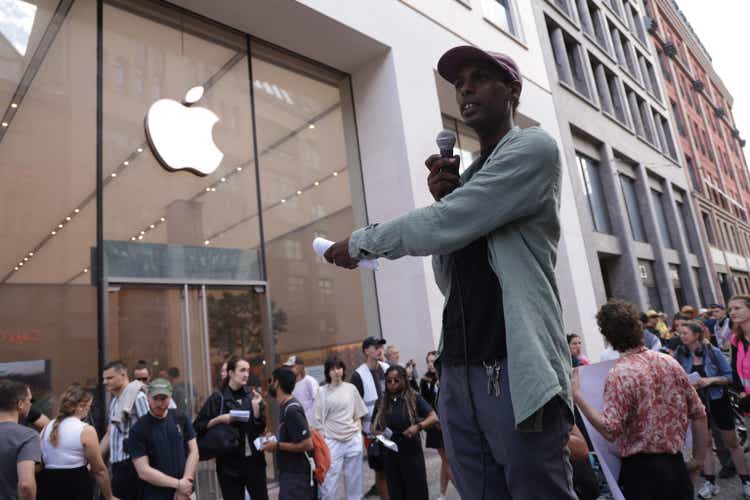
Berlin Apple Store Sean Gallup/Getty Images News Apple Inc. ’s ( NASDAQ: AAPL ) September 2024 event concluded just a few hours ago. As expected, the event revealed a new iPhone, along with several other minor product updates.
The iPhone 16 got a smaller yet functionally equivalent camera to the iPhone 15, as well as a new A18 chip optimized for AI processing. Other product announcements at the event included an Apple Watch with a larger screen, and new AirPods with better noise-cancelling than the previous model. The event included plenty of new details on Apple Intelligence, Apple’s new suite of AI features that will be embedded across apps like photos, Pages and Siri.

The inclusion of AI in Siri was a definite plus, as that feature was long thought to be far behind Google’s ( GOOGL ) ( GOOG )’s Assistant . The market’s reaction to Apple’s new products and features was muted. As of 4PM, the stock was up 0.
07% while the NASDAQ-100 represented by Invesco QQQ Trust ETF ( QQQ ) was up 1.3% . The social media response to Apple’s event was equally underwhelming.
X users noted a lack of meaningful changes in the new products (although some appreciated the new camera control button ). Immediately after the event ended, reviewers noted the slow rollout of some products to international markets--notable given Apple's troubles in China. As an Apple customer, I found the September Event satisfactory.
I expected incremental improvements, and I got them. As an investor looking at this event in light of AAPL’s 33 P/E ratio , I had mixed feelings. While the event showcased some quality products, none of them were game changers of the sort that could unlock large new revenue streams for the company.
That’s significant because Apple operates at a massive scale, and would require a truly enormous, successful product launch or investment to move the needle on the bottom line. Apple did $101 billion in net income last year. It grew its revenue 0.
43% in the trailing 12-month period. The company can incrementally increase its earnings by hiking prices and/or gaining share, although the iPhone 16 had the same price points as the previous model and market share gains are impossible to predict. Without a game-changing new product launch, it seems unlikely that Apple will return to its previous status as a “high growth” stock.
Such a game-changing product launch would be difficult to deliver, as it takes $1.01 billion in fresh new profit just to increase Apple’s net income 1%! The company has managed to juice its earnings per share (EPS) growth through its massive buyback program, but at $110 billion , those buybacks don’t come cheap. When I last covered Apple, I called the stock a “buy” because of its then-new AI features.
The rating paid off, with Apple outperforming the S&P 500 since I made it. Today, I am less enthusiastic. Apple’s September event showed product improvements that increase Apple’s likelihood of retaining its current market share, but did not provide any hope of a ramp up in growth.
For this reason, the stock appears overpriced, but simultaneously, likely to retain its high market share and margins. So, this time around I will include some thoughts on the level at which I would buy Apple, which I didn’t touch on in my previous article. September Event Recap Apple’s September event was fairly typical of the company’s recent events, including incremental product updates and refreshes.
Some of the most notable announcements included: Apple Watch - The new model has a larger screen and a thinner build. It does not have improved battery life , a feature I’d need to see before seriously considering buying it. The iPhone 16 - The new camera is smaller without compromising on photo quality, and the device has a dedicated camera button which allows you to get AI insights about things in your environment while pointing the camera at them, among other things.
The iPhone 16 Pro - This one is less changed from last year’s model compared to the 16 and 16 Plus, but it does come with a new slow motion video feature, which may make it more useful for filmmakers. AirPods with new clinical-grade hearing aid functionality. Minor new Apple Intelligence features, including camera integrations and Photo search .
Overall, the features all looked nice, but the new products did not include anything game changing. The incremental nature of the product announcements would seem to corroborate the claim, frequently made, that Apple’s growth avenues at this point are limited to price hikes and share gains. No doubt, the company enjoys some pricing power in the U.
S., but it has been cutting prices in foreign markets, so it’s not clear exactly how much growth the company can achieve through price hikes. Apple achieving meaningful growth rates at its current scale would be challenging.
It would require either a massive new product launch or some unprecedented improvement to the iPhone that captured so much market share that it had a revenue impact comparable to a massive launch. As I wrote in my recent QQQ article , the company is so big now that it takes tens of billions in new revenue to move its profit needle. Apple has a 26.
4% net margin. It takes $3.82 billion in new revenue to generate $1.
01 billion in new profit (or 1% earnings growth) at such a margin. It would take $38 billion in new revenue to produce $10.1 billion in earnings growth–about what the entire wearables category did last year ! The above is likely why Apple spent billions of dollars researching an electric car before shelving the product, and why it proceeded with the $3,500 Vision Pro despite criticisms about the price point.
It takes a truly massive, successful investment to move the profit needle at Apple’s scale, and the company doesn’t appear to be finding any such investments to make. Valuation The above points about why growth is so hard for Apple might sound like nit-picking. The company has a 26.
4% net margin, after all; does it even need growth? At its current valuation, it does. Apple currently trades at the following multiple s: 33 times earnings. 8.
6 times sales. 50 times book value. 30 times operating cash flow.
33 times free cash flow . It’s a pretty steep valuation. Even if you assume that Apple can grow its profit at 10% per year for five years before levelling off to 5% growth afterward, it’s only worth $175 using a 10% discount rate.
This DCF valuation assumes a fair amount of growth, but nothing shown at Apple’s September event appears likely to produce more than some incremental growth from price hikes. With that said, Apple's new products were quality enough that we can reasonably expect the company to retain its current user base, or perhaps even capture small amounts of market share. The company does not look likely to shrink because of what we saw today.
If you assume 0% growth and use a 3.71% discount rate , you get a $182 price target (a lower discount rate is justifiable here because of the more conservative growth estimate compared to the previous DCF exercise). So, $182 is about where I'd consider jumping back into Apple.
The Bottom Line Apple is clearly a great company. It has great products, high margins, and a very loyal customer base. However, no company is worth an infinite price.
To justify its current valuation, Apple needs to achieve growth. The problem is: It’s not clear where such growth will come from. The company shelved its most ambitious recent project (the car), the Vision Pro isn’t selling well , and the products announced at the September event amount to little more than incremental upgrades.
There’s nothing happening here indicating that investors who short Apple will make money, but there’s nothing happening indicating much upside either. So, Apple is a weak “hold” for me at today’s prices. Analyst’s Disclosure: I/we have a beneficial long position in the shares of GOOG either through stock ownership, options, or other derivatives.
I wrote this article myself, and it expresses my own opinions. I am not receiving compensation for it (other than from Seeking Alpha). I have no business relationship with any company whose stock is mentioned in this article.
Seeking Alpha's Disclosure: Past performance is no guarantee of future results. No recommendation or advice is being given as to whether any investment is suitable for a particular investor. Any views or opinions expressed above may not reflect those of Seeking Alpha as a whole.
Seeking Alpha is not a licensed securities dealer, broker or US investment adviser or investment bank. Our analysts are third party authors that include both professional investors and individual investors who may not be licensed or certified by any institute or regulatory body..














